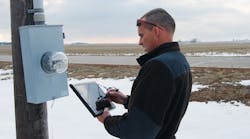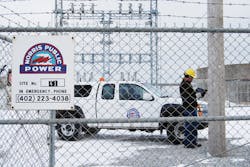For more than 50 years, all service at Norris Public Power District in southeast Nebraska was dependent on a paper-based system. Equipped with service orders, the Norris linemen would gather their paperwork each morning and head out for the day with stacks of paper in hand. After completing their assigned tasks — performing maintenance work, completing meter cutoffs, disconnecting services, constructing new facilities, repairing and exchanging meters, and making upgrades and repairs — the linemen would fill out paperwork by hand at each job site. It wasn’t until they returned to the office the next day that they would turn in their service orders for customer service representatives (CSRs) to manually upload the day-old information into the database.
While the paper-based system worked, it was inefficient. The amount of paper moving in and out each day increased the possibility of lost or misplaced forms. In addition, the handwritten paperwork could be illegible, requiring the CSRs to send it back for clarification. Errors such as these would often require a lineman to return to the completed job twice. Storage also was an issue because of the ever-increasing amount of paperwork.
Mobile Computing Solutions
Norris began looking at mobile computing options to reduce the daily volume of paper that came into the office —a solution that would enable the linemen to reduce errors, become more efficient and support real-time communication with CSRs to ensure the highest quality of service possible.
Linemen are outside in all types of weather, so the utility needed a device that could stand up to rain, wind, snow and dust, and be able to take a beating. Linemen are not known for being gentle. Norris knew the devices would likely get dropped, so it was concerned about replacing the devices on a regular basis.
Other requirements included a Windows-based operating system, compatible with existing software applications; a powerful processor; a viewable display, even in direct sunlight; and the ability to be mounted in trucks and locked in place. The devices also needed to be light enough to be carried all day.
Norris began reviewing rugged laptops. Unfortunately, the laptops proved too heavy and cumbersome for linemen to carry around all day. It then looked at rugged tablet PCs. After reviewing all the options, Norris selected the Motion J3500 tablet PC, powered by the Intel Core i7 vPro processor with Qualcomm’s integrated Gobi mobile broadband.
Enhanced Workflow and Customer Service
Linemen at Norris now rely on tablets to access their schedules and service orders, process meter readings, update the database and access real-time information in the field. If a service order comes in, at any point in the day, a CSR is able to assign the job to the closest lineman based on the GPS location. Before moving to this system, a service order could take three to four days to complete. Orders now can be assigned in real time and more are processed in a single day, with the information sent directly to the right department.
The linemen also are able to resolve issues in the field better. Instead of simply completing their assigned tasks, they are equipped with the tools to diagnose a potential problem and able to make any necessary changes on the spot, saving Norris valuable employee hours and fuel expenses.
The end result is that Norris is improving the customer experience. Many service orders are closed by the linemen in the field, eliminating the need for a CSR to handle a service order at all, freeing up their time to do other tasks. In addition, because the database is updated in real time with information sent directly to the linemen, the linemen will have the most up-to-date information to do their jobs.
Norris also has incorporated the use of the Motion J3500 tablet’s integrated camera to take pictures of suspected meter tampering or other issues the linemen may see in the field. All pictures are time- and date-stamped with the tablet’s GPS location to help document cases for later use.
The linemen also view maps on their tablets. They can view power line locations and drill down to information quickly and easily, providing more detail than a paper map could supply.
In the future, Norris plans to use the tablets to manage its power outage management system. For example, during a storm, the utility will be able to alert linemen in real time with the tablets when customers experience power outages, providing the outage location and alerting them when power has been restored. This capability will allow Norris to manage the linemen more efficiently and restore power to customers sooner.
All of these enhancements translate into time savings and improved customer service. By reducing the amount of time linemen are in the field processing paperwork, Norris has been able to increase the number of service orders it processes on a daily basis, and provide more efficient and accurate service.
Norris linemen have come to depend on these tablets. They have found the computers help them to do their jobs better and more efficiently, providing them with more data at their fingertips. They have taken more ownership in their work, knowing everything is not being double-checked back at the office. In addition, the linemen have requested that more service orders be moved over to the tablet to eliminate all
paper service orders.
Training for Success
After making the decision to move to a mobile computing solution, Norris’ IT department began working on a plan to train the linemen. The linemen had various amounts of computer knowledge; some were very comfortable with a computer and others did not know how to access the Internet. However, none of the linemen had ever used a tablet computer before.
Training began on a very small scale at a basic level. To help the linemen learn how to operate the computer and become acquainted with the tablet’s stylus, they were shown how to surf the Internet, play games and take pictures with the camera. The linemen also were encouraged to take the tablet home to become more comfortable with the device.
Once the first process was complete, technical training began by bringing in small groups to practice completing the most basic service order. Initially, the tablets went live with a single service order type so the process would not overwhelm the linemen. Once everyone felt comfortable with processing that service order, the IT department would bring the groups back to answer questions and introduce a new service order. Eventually, the linemen became so comfortable with the service orders that training sessions ceased. Today, if a new order is introduced, the IT department simply sends an e-mail with instructions.
Part of going mobile is improving how data flows through an organization. Norris took a look at the entire service order process to improve efficiency with both the tablet and the
service order process. The utility’s goal was to streamline both. Today, processing an order takes less time in the field as well as in the office, with each user processing a service order in the same way, thereby increasing productivity.
Addressing Field Challenges
Changes always come with challenges. For Norris, a big challenge was field access. Trying to have a lineman explain a computer problem over the phone, especially when he or she does not have a background working with computers is not an easy thing to do. The IT department knew it would be easier to work through any problems the linemen were experiencing if they also could view the same screen. To solve this issue, a remote desktop client was installed on each tablet. Today, if a problem does arise, IT is able to access the tablet remotely to answer questions and solve any problems in real time.
In southeast Nebraska, there are many areas where cellular coverage is lacking. While the software will run without connectivity, two of the best benefits of moving to a mobile solution — real-time access and updates to the data — would be lost. To solve this issue, a cellular signal booster was installed in every truck to increase connectivity.
Planning Pays Off
A successful move to a mobile computing platform takes a good deal of planning. Taking the time to select the right mobile solution is key. In addition, understanding the technical knowledge of the user base and allowing ample time for training and support are paramount to success. Once the system has been deployed, IT personnel should be readily available to answer support calls and provide assistance to employees in the field. Eventually, users will become more proficient and less time will be spent on support.
Norris is pleased with the results of the move to a mobile platform. Today, tablets help the linemen and the organization to work more efficiently and have increased employee satisfaction. In addition, the entire workflow process from the office to the field and back has been streamlined, reducing errors, increasing productivity, and saving time and costs.
Ryan Krupicka ([email protected]), director of consumer and business information systems, oversees customer management, accounting, staking and mobile workforce software at Norris Public Power District. Krupicka also trains users on new features and manages new projects with regard to testing, implementation and training.
Companies mentioned:
Intel| www.intel.com
Motion| www.motioncomputing.com
Qualcomm| www.qualcomm.com




